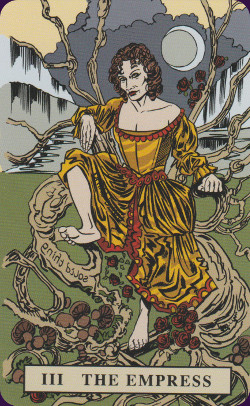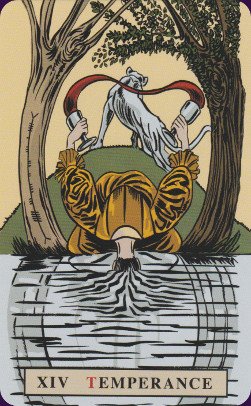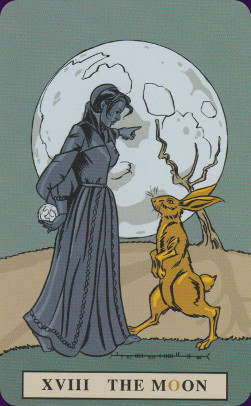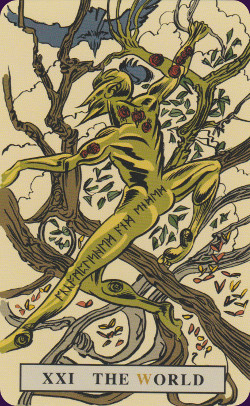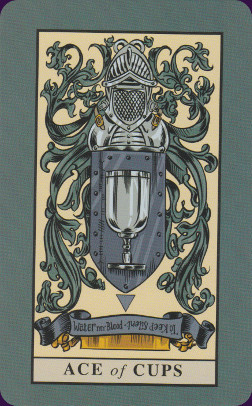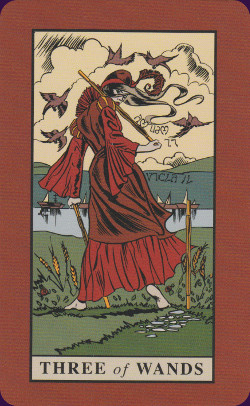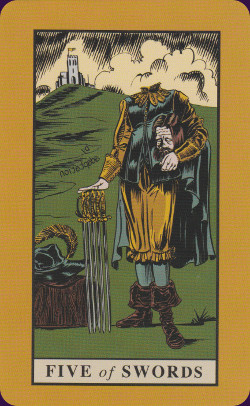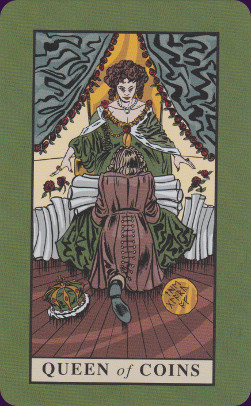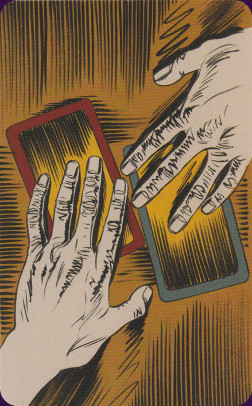English Magic Tarot Deck Review
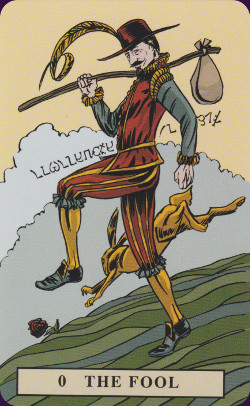
The English Magic Tarot is a 78 card deck set in the 16th century period of English history, known as a golden age for magic and mysticism. The cards feature deceptively simple, non-traditional Tarot scenes with hidden occult-related riddles, illustrated in a comic-book style.
Deck Type: Tarot Deck Cards: 78
Creators: Rex Van Ryn, Steve Dooley, Andy Letcher
Publisher: Weiser Books 2016
Retailers
See Price at Amazon.comSee Price at Amazon.co.uk
See Price at Amazon.ca
English Magic Tarot Review by Medusawink
The English Magic Tarot is an unusual and engaging deck full of deceptively simple images that challenge the Seeker to look closer and think more deeply about what they are seeing, learning, and divining.
The card’s illustrations are set in the period of time starting with the reign of King Henry VIII and finishing at the end of the Elizabethan era, approximately 1509 - 1603. Under the reign of Elizabeth I in particular the study and practice of magic thrived. The creators of the English Magic Tarot (EMT) specify that English magic is a branch of natural magic that focuses on local lore and phenomena. Natural magic seeks to identify and utilise disparate elements of nature and unify it with 'academic’ occult knowledge, in order to bring about a desired result. Particular attention is paid to this unification of High (academic) Magic and Low (folk) Magic and how it has taken effect on the development of tarot. Keeping this in mind the creators of the EMT have shorn a lot of esoterica from their tarot images – complex imagery being less of a gateway to in understanding, and more of a barrier.
The card images have been created with the idea that as they tell stories, then the same characters may appear in different images/situations, or that several cards may depict the same as scene from differing points of view. Influenced by English artist Kit Williams and his famous puzzle/cipher books Masquerade, and The Bee on the Comb – the cards are far from the simple images they initially appear to be.
Hidden in the illustrations are various riddles for the Seeker to uncover, along with appropriate phrases and keywords in several alphabets including mirror script, Ogham, Futhark Runes, and the Enochian Alphabet of Dr John Dee.
This is a 78 card fully illustrated tarot deck. It has a 22 card Major Arcana with no changes to titles, and adhering to the order established by AE Waite. The Minor Arcana consists of 56 cards divided into four suits – Cups, Swords, Wands, and Coins. Each suit has 10 number cards and 4 Court cards – Page, Knight, Queen, and King.
The cards measure 75 x 120 mm which makes them fairly average in size for a tarot deck. The card stock is excellent, being light and flexible, yet sturdy. The face of the card has a smooth finish, however the back has the faintest of toothy texture. The finish in general is low sheen. The cards have a nice weight to them, they sit well in one's hands, and they are easy to shuffle.
The print quality is excellent. The dynamic comic-book art style of illustration is well reproduced with clean crisp lines. While the artist’s palette is quite limited, presumably in homage to the comic-book art from which this style is drawn, the colours are nonetheless rich and strong. The suits of the Minor Arcana are denoted by their colour-coded borders – rust brown for Wands, tobacco brown for Swords, ‘grise’ for Cups, and olive green for Coins. Other colours which predominate in this deck include cream, ruby red, mustard yellow, grey, moss green, pumpkin orange.
Rex Van Ryn is a comic book artist who has bought his skills to these dynamic images, while the bold palette is supplied by Steve Dooley. The Arcus Arcanum Tarot was drawn in a similar style – recollecting the heyday of serial comics such as Prince Valiant and Flash Gordon. While some illustrations pay homage to Pamela Coleman Smith’s tarot artwork, there is no rigid adherence to her imagery, indeed there are many charmingly original interpretations given in the English Magic Tarot.
While the Minor Arcana have colour-coded borders, the Major Arcana are borderless images, with numbers and titles contained in a narrow box at the bottom of the image. The picture on the back of the cards shows two hands atop 2 different coloured cards. This is not strictly a reversible image, however there is enough symmetry in it to avoid being a distraction.
The cards come packaged in a solid cardboard box with liftoff lid. The box is narrow enough to fit into a large shoulder bag or backpack, and made to withstand the rigours of travel. The cards, divided into two piles sit in a well inside the box, with the guidebook on top of them.
The 149 page guidebook is written by the English Magic Tarot deck’s creators Rex Van Ryn, Steve Dooley, and Andy Letcher. The Introduction aims to acquaint the Seeker with the period of English history in which the deck is set. It contains a sizeable explanation of what English magic actually is. There is a discussion, albeit brief, about Alan Moore and his influence on storytelling, art, magic; as well as a broader discussion of stories as personal histories.
This is followed by a (for once) interesting description of the genesis of the English Magic Tarot deck. Signposts on the Way introduces the Seeker to the cards. Each Major Arcana card has 2 pages of information – a black-and-white reproduction of the card, a brief phrase that summarises the essence of the card, a Description, Interpretation, and divinatory meaning.
The Description is simply a few lines describing the image in the card. The Interpretation describes the less tangible qualities depicted in the cards – the emotions, the thoughts, the possible identity of the character in the cards, what the card represents, and an analysis of any significant symbols. Reading – this is the divinatory meaning, and they are given for both upright and reversed cards. These interpretations are an interesting melding of both traditional meanings and modern applications of the traditional meaning, as well as sage advice. Minor Arcana cards have the key phrase, Description, Interpretation, and Reading – however these are all considerably briefer than those of the Major Arcana.
Part Three – Using the Cards offers some advice about practices and rituals for reading the cards. Included here are 4 layouts including the Two Ravens Spread, Three Sisters Spread, The Prism Spread, and The Broadside Spread.
In the final section of the book the authors share a technique for building The Memory Theatre, which is a version of Sherlock Holmes’ Memory Palace, only for magic and tarot cards. This is quite a detailed practice, and one that, to my knowledge, has not been proposed for tarot card practitioners before.
This is an energetic and potent deck full of uncommon wisdom and guidance. Part of its power lies in the sleight-of-hand imagery, and part lies in its ability to identify and articulate issues and ideas. A great deal of thought and knowledge has gone into creating this fascinating and highly original tarot.
If you love classic comic book illustrations or are drawn to puzzles and ciphers then this deck will prove to be almost irresistible. If you are interested in English Magic then this deck is something that you may wish to look into.
While the English Magic Tarot would not be the easiest deck for a novice to use, due to its lack of traditional imagery, anyone who has got the fundamentals of tarot reading down will find this deck intriguing and easy to master. There is a lot to discover in this original and interesting tarot deck.
English Magic Tarot Review by Mythic Silence
“The English Magic Tarot” is a 78 card Tarot deck and book set written by Andy Letcher with a foreword by Philip Carr-Gomm. The deck is illustrated by Rex Van Ryn and Steve Dooley, and published by Weiser Books. The cards measure 3 x 4.75 inches and the backs are not reversible.
Content: As one would expect from a deck entitled “The English Magic Tarot,” the Golden Dawn’s elemental associations are utilized and the suit names are the traditional Wands, Cups, Swords, and Coins. The card borders are color coded for each suit, and the font on the cards is easy to read. The deck is rich enough to offer fresh, thoughtful ideas and details without overwhelming the user with esoteric content. I found it accessible without being stripped down. The deck is Rider Waite influenced, but much of the imagery and card meanings deviate from standard Rider Waite interpretations.
The court card descriptions often focus on problematic qualities and behaviors that people can exhibit. I relished some of the fresh ideas here, as I am always excited to add new dimensions to my interpretation of the court cards. This attribute of the deck made the characters seem more realistic, and I loved the way that the figures were rendered to reflect potential character quirks. That being said, if you are new to Tarot and don’t have a lot of other resources on the court cards, it might be a bit challenging to extract their positive qualities. For example, The Queen of Cups card focuses more on insobriety, suffering from old pain, and lashing out at others than it does on positive manifestations of sensitivity or compassion.
One of my favorite nuances of this deck is that there are riddles and messages included in the cards. Runes, Ogham, mirrored text, and Enochian letters are incorporated into the card designs, adding an extra level of meaning and detail for those who wish to decipher the messages. Even some of the card titles feature one letter of another color – a deliberate clue to encourage you to study the cards in a new way and see what you can uncover!
Some historical figures, such as Henry the VIII and Sir Isaac Newton, make an appearance in the deck, but not every card has a historical figure in it - they are used somewhat sparingly. They give the deck extra flavor without overpowering it. I appreciated the thoughtful balance between utilizing historical figures to represent important card themes, and including enough anonymous figures to give the deck flexibility and encourage personal associations and ideas.
Artwork:
The art style of this deck is illustrative, and reminiscent of a graphic novel. Bold lines, dramatic poses, and warm, vibrant colors fill the cards. Rex delivers characters that are active, emotional, and expressive rather than physically idealized and stiff. They have personality and life to them. They grimace and glare; they look worn, tired, or ecstatic. No airbrushed faces stare at you from these cards, and I personally felt that this made the deck more readable and engaging.
Another aspect of this deck’s artwork that greatly pleased me was that both male and female figures were represented throughout, making it a very balanced deck. Nudity is minimal, and harsh cards such as the 10 of Swords retain their negative aspects without being overly graphic or morbid.
The Wheel of Fortune was one of my favorite cards because of its fresh design of a woman standing in the center of a ring of Tarot cards. Often this card is fairly standardized across decks, and I appreciated the creative and effective image in this deck. Another card I was particularly fond of was the Queen of Coins for its tastefully executed innuendo between the Queen herself and her servant.
Quality:
The outer packaging is a compact and sturdy cardboard box with a lift off lid, which makes the deck easy to store. The cardstock is moderately thick, and the lamination is a pleasant finish for shuffling and fanning. Scuff marks might show after extended use, but overall the cards seem sturdy enough to withstand regular handling.
Extra Materials (Book): The 149 page companion book provides a basic overview of relevant English history and the English Magic tradition. The bulk of the text is comprised of descriptions of the individual cards. Each entry includes an image of the card, keywords, a description of key details in the image, and additional information for readings and interpretation. The final portion of the book is devoted to spreads and an exercise called “The Memory Theatre.” A recommended reading list that covers topics in Tarot, English Magic, and even related fiction, is also included. The writing has a warm, conversational style, and the content contributes relevant and practical information for working with the deck.
Conclusion:
This deck is an excellent choice for Tarot users familiar with the Rider Waite tradition that are looking for something familiar, yet fresh enough to generate new perspectives and insights. It is also a great choice for those who are fond of Ogham, Runes, and English Magic, though thorough knowledge of these subjects is certainly not required to make good use of the deck. If you are a fan of illustrative, graphic novel style artwork, and are seeking a tasteful deck with both male and female figures, this Tarot is definitely worth a look!
Complete Details of English Magic Tarot
Creators: Rex Van Ryn, Steve Dooley, Andy LetcherPublisher: Weiser Books 2016
Deck Type: Tarot Deck
Cards: 78
Suits: Cup, Swords, Wands, Coins
Court Cards: Page, Knight, Queen, King
Card Size: 3.00 x 4.75 in. = 7.62cm x 12.07cm
Card Language: English
Card Back: Non-reversible
Back Design: Mirrored image of two hands, one covering a red bordered card and the other a blue bordered card.
Companion Material: 149-page guidebook is included with the deck, with information on English magic, the period of English history the deck is set in, card descriptions and meanings, and how to use the cards.
Rating: 18/20 or
Similar Decks to English Magic Tarot
Theme: Historical, OccultCategory: Available Tarot Decks
< Previous Deck · Back to Top · Next Deck >
Home > Tarot Reviews > English Magic Tarot Review

